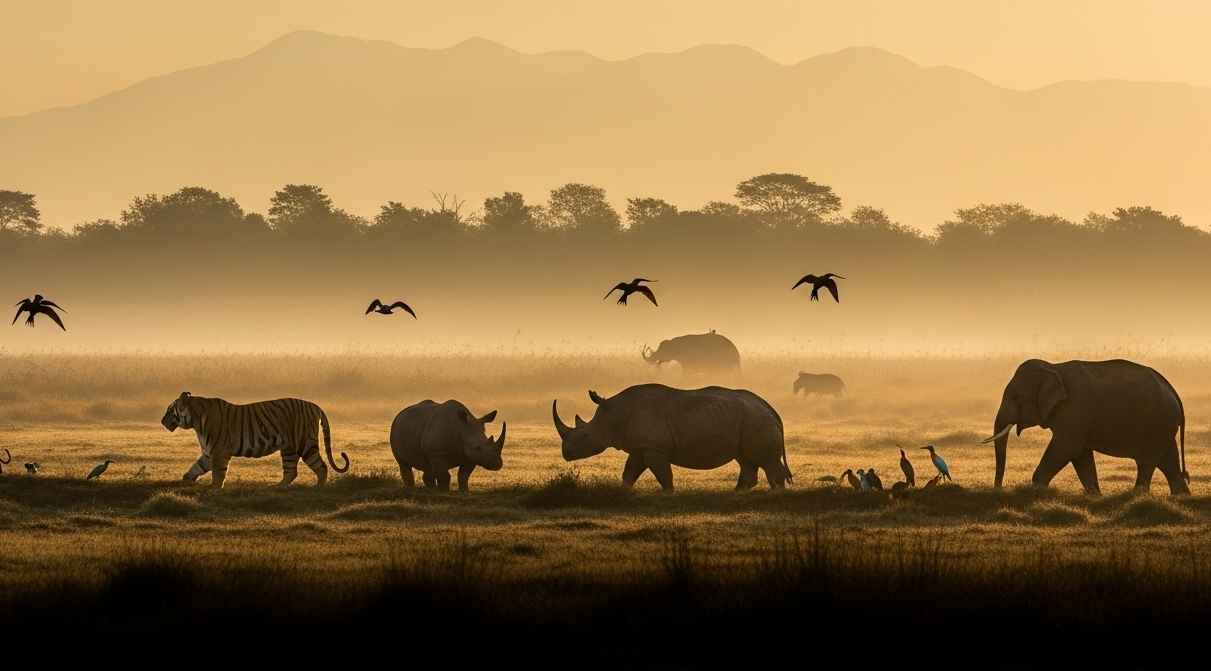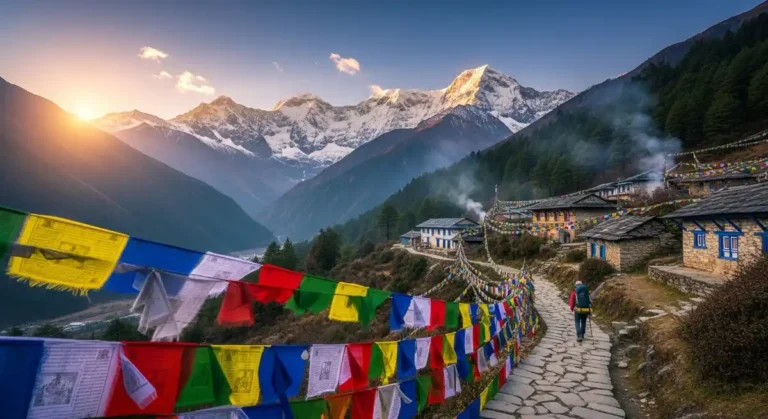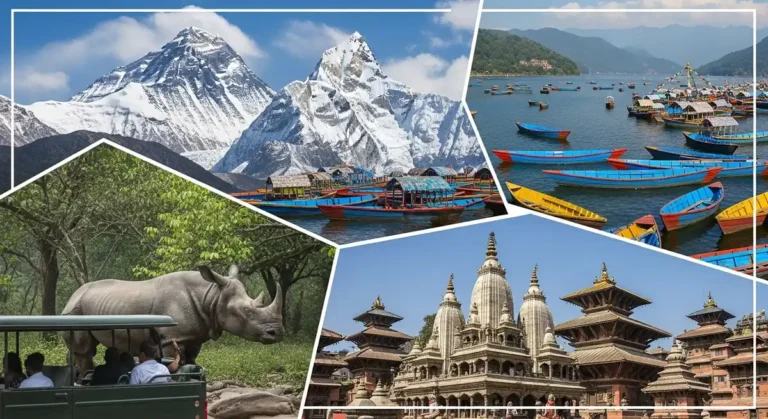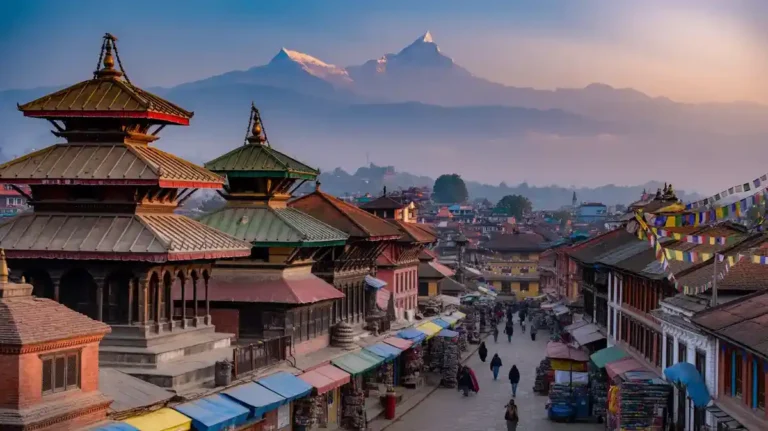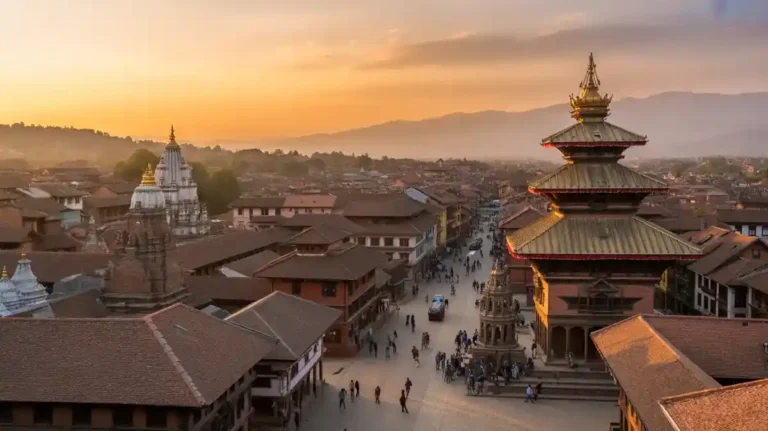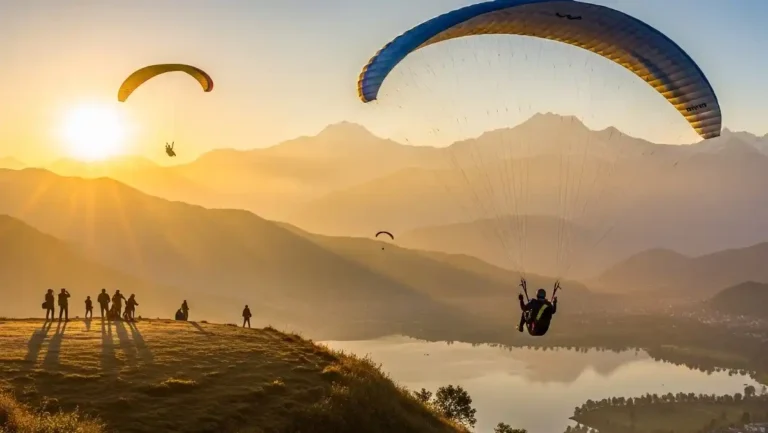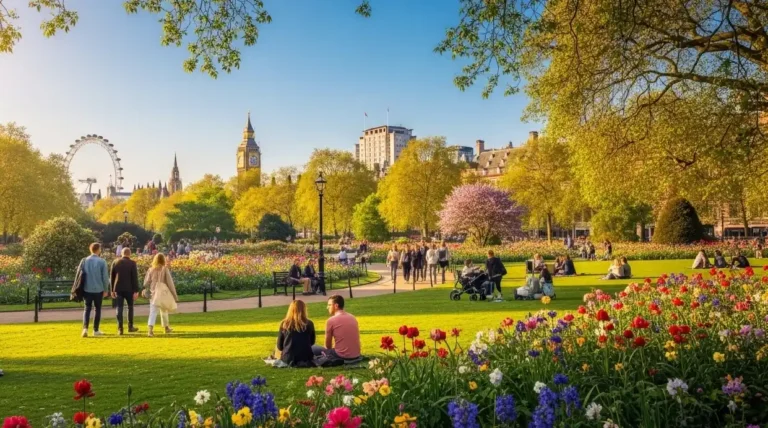Chitwan or Bardia? Pick Your Perfect Jungle Escape (2025)
Chitwan or Bardia National Park — these are two of Nepal’s finest destinations for unforgettable wildlife experiences. Both parks are located in the Terai region and are home to amazing species like rhinos, Bengal tigers, crocodiles, bird species, and many other wild animals.
They each have unique features that make them special depending on the type of safari adventure you’re looking for.
Chitwan National Park, close to Kathmandu, is very accessible. A 5-hour drive or a 25-minute flight takes you to Sauraha, a charming town with riverside restaurants, beautiful views, and many guided activities.
Here, you can enjoy jeep safaris, canoeing, and walking safaris. The park has a rich mix of grassland, sal forest, and marshes, making it perfect for wildlife viewing. It also has a well-developed tourism setup and plenty of tour options.
Bardia National Park lies further west and offers a peaceful, authentic jungle experience. Though it takes around 17–18 hours by bus, this extra journey rewards visitors with serene wilderness, dense forest, and fewer crowds.
The park is known for frequent tiger sightings and thrilling jungle hikes. Along the Karnali River, you might even see crocodile sightings or rare bird species.
It’s an excellent spot for those who enjoy solitude, natural beauty, and a deep connection with the ecosystem.
Both parks offer unique and exciting opportunities for animal encounters, depending on your travel style.
Whether it’s Chitwan’s easy access and variety or Bardia’s tranquil, remote charm — either choice guarantees an amazing safari adventure in the heart of Nepal’s biodiversity.
Quick Comparison Table: Chitwan vs Bardia at a Glance
Chitwan offers easy access, diverse wildlife, and developed safari options, while Bardia provides a peaceful, natural setting with higher tiger sighting chances and adventurous activities.
| Feature | Chitwan National Park | Bardia National Park |
|---|---|---|
| Location | Closer to Kathmandu, in central Terai | West of Nepal, more remote |
| Accessibility | 5-hour drive or 25-minute flight from Kathmandu | About 570 km, 17–18 hour bus ride, or flight to Nepalgunj + 3–4 hr |
| Atmosphere | Developed, popular, more amenities, comfortable | Natural, authentic, less crowded, peaceful |
| Wildlife Focus | Rhinos, Bengal tigers, elephants, birds, other animals | Bengal tigers, rhinos, elephants, bird species |
| Tiger Sighting | Moderate, due to dense jungle | Higher chance, thanks to open grasslands and riverine forests |
| Popular Activities | Jeep safari, elephant ride safari, canoeing, bird watching, cultural tours | Jungle walks, rafting, fishing, night camping, cultural experiences |
| Unique Experiences | Spotting rhinos in Sauraha, developed tourist infrastructure | Remote safari, Tharu culture, open terrain |
| Best Time to Visit | March–April (dry season), October–November (lush post-monsoon) | March–April, October–November (same seasons apply) |
| Transport Options | Many bus companies from Sorhakhutte (near Thamel) at 7 a.m. | Flight to Nepalgunj, then local bus, or long-distance bus ride |
| Travel Comfort | Shorter travel time, more tourist-friendly | Adventurous journey, rewarding natural experience |
Location & Accessibility: Which Park Is Easier to Reach?
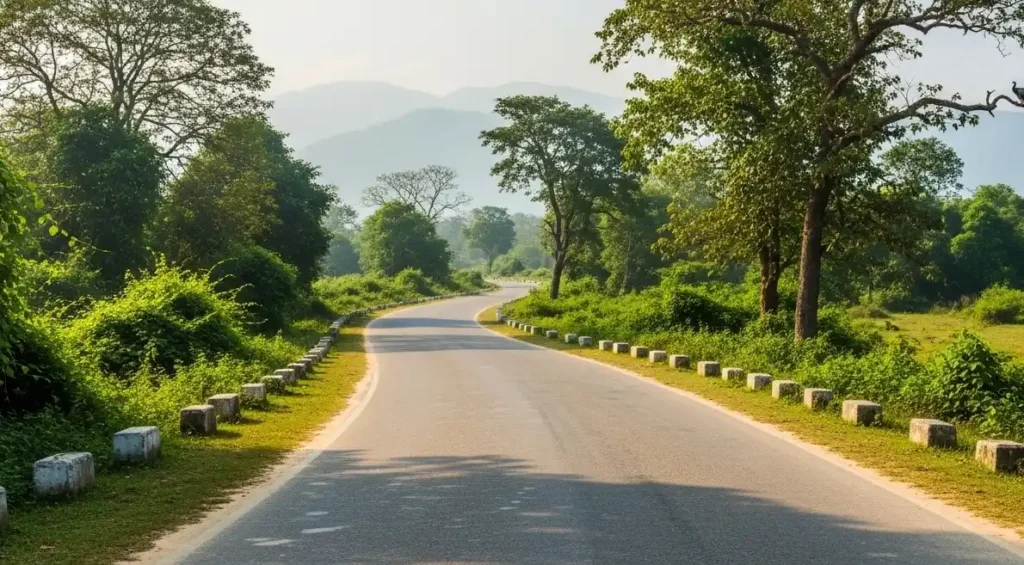
Where Is Chitwan National Park Located?
Chitwan National Park is situated in the central Terai region of Nepal. It’s close to Kathmandu, Pokhara, and Lumbini, making it easily reachable from major cities. With well-developed infrastructure, the park is located near popular towns like Sauraha and Barauli, attracting both domestic and international visitors.
Where Is Bardia National Park Located?
Bardia National Park lies in the Far Western Terai, near the northern Indian border. It is known for its peaceful atmosphere, rich wilderness, and scenic beauty. Surrounded by sal forest, grassland, and the Karnali River, this area offers a more tranquil, immersive nature experience.
How to Get to Chitwan from Kathmandu, Pokhara, and Lumbini
Reaching Chitwan is quick and convenient. From Kathmandu, visitors can travel by road (around 5–6 hours) via the Prithvi Highway and Mahendra Highway. There are many tourist buses departing around 7 am from Sorhakhutte near Thamel.
Alternatively, a flight from Tribhuvan International Airport to Bharatpur Airport takes under an hour. From Pokhara or Lumbini, you can take a bus, car, or private vehicle, with travel times between 4 to 6 hours. Hop Nepal and Welcome Nepal Treks Pvt. Ltd. offer advance booking and tourist services for all routes.
How to Get to Bardia from Kathmandu or Pokhara
Getting to Bardia requires a bit more travel time but is still manageable with the right plan. The fastest route is a flight to Nepalgunj, followed by a private transfer or local bus to the park area near Thakurdwara or Ambassa. Total travel time from Kathmandu or Pokhara can range between 6 to 8 hours.
You can also take a direct bus, which may take 14–18 hours depending on the route. Though the park is more remote, its scenic location and peaceful atmosphere offer a unique experience.
Park Entry Fees and Permit Info (Updated for 2025)
Visitors to Nepal’s two most iconic national parks—Chitwan National Park and Bardia National Park—can enjoy easy access through clearly defined entry fees and permit guidelines.
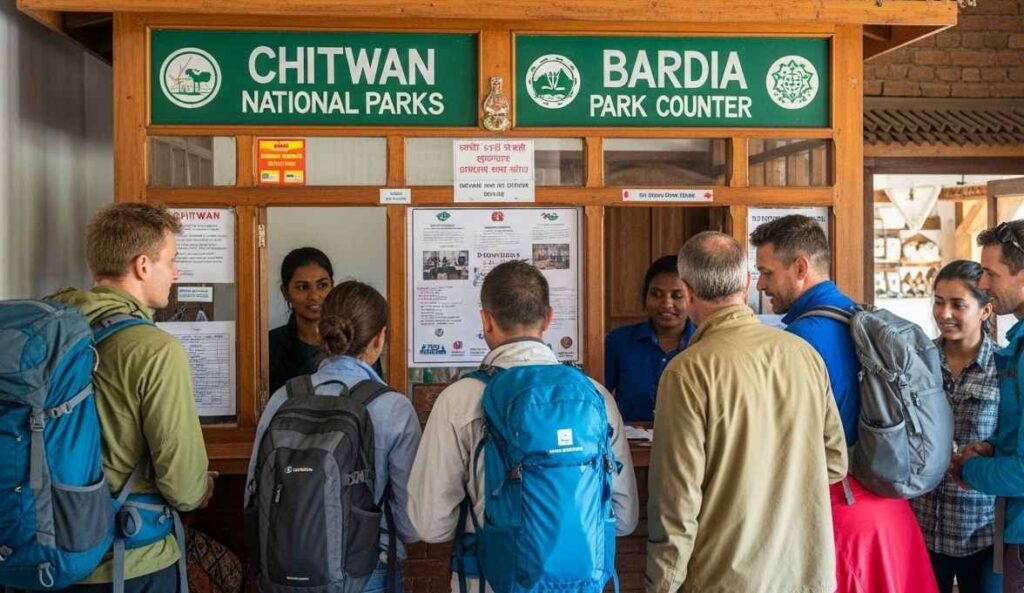
Whether you’re a local traveler or an international guest, updated rates for 2025 help make the process smooth and well-organized.
Tickets are available through authorized agents, official websites, and at designated ticket counters.
Most organized tours also include permit arrangements, allowing visitors to focus on their safari or wildlife experience.
Chitwan National Park Entry Fees (Per Person Per Day)
- Foreign Nationals: NPR 2,000
- SAARC Nationals: NPR 1,000
- Nepali Citizens: NPR 150
Bardia National Park Entry Fees (Per Person Per Day)
- Foreign Nationals: NPR 1,500
- SAARC Nationals: NPR 750
- Nepali Citizens: NPR 100
Key Permit Info & Guidelines
- Entry is charged per person per entry and per day.
- For multiple-day visits, a new ticket must be purchased for each day.
- Permits may also be needed for specific areas or activities like jungle safaris or elephant rides.
- Additional costs may apply for extra services during your visit.
- It’s best to verify all fees, rules, and regulations on the official website or with authorized agents.
- All fees are subject to change, so ensure your information is current and valid before booking.
These straightforward entry policies contribute to sustainable tourism and enhance the overall travel experience in Nepal’s protected natural areas.
Weather & Climate: What to Expect Year-Round
Chitwan and Bardia National Parks in Nepal offer unique wildlife experiences year-round. Winters are cool and ideal for safaris, summers are warm and active, and monsoons bring lush jungle views.
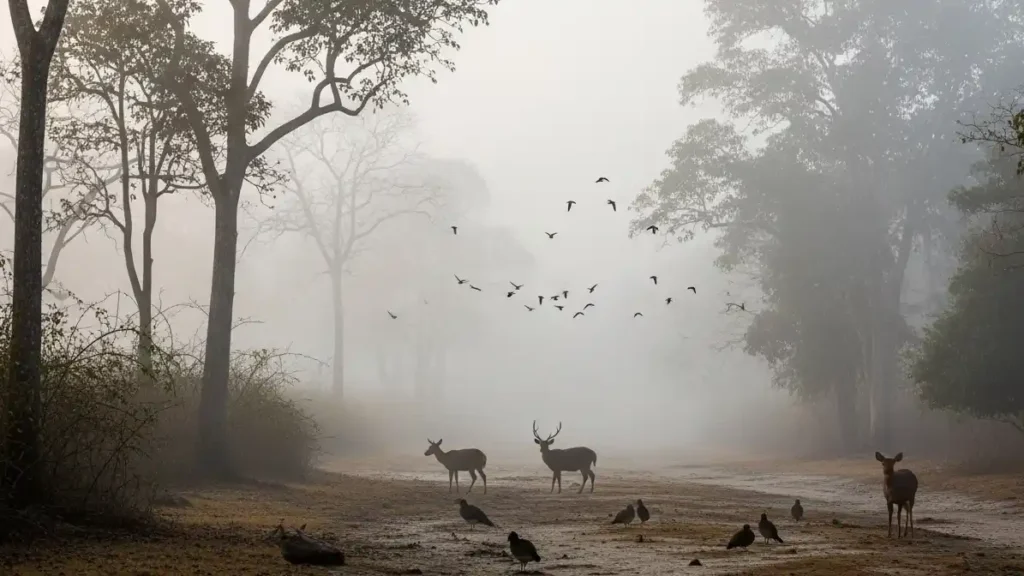
Each season affects wildlife visibility and jungle access differently, making timing important for planning the perfect visit.
Seasonal Breakdown: Summer, Monsoon, Winter
Summer (March to June):
The Terai Region becomes hot and dry. Temperatures often range between 25°C/31°C to 30°C/36°C, especially in April and May. Early mornings and late afternoons are pleasant for activities like safaris and trekking. Jungle dryness offers better visibility, making it ideal for wildlife spotting. Fewer clouds mean crystal clear skies and lots of sunshine.
Monsoon (June to September):
The monsoon season brings heavy rains, especially in July and August, with rainfall reaching up to 691mm. The jungle turns lush and dense, filled with green foliage, waterholes, and active wildlife.
Though some trails may become slippery due to rainfall, it’s a great time for viewing vegetation and natural beauty. Rivers like Karnali and Girwa swell with water, creating great safari opportunities near congregating animals.
Winter (October to February):
Cooler temperatures and less humidity make this the best time to explore jungle areas. Temperature ranges vary from 4°C in January (coldest month) to 15°C/24°C in November. Foggy mornings in December and January give way to sunny afternoons.
The dry season creates high chances of spotting tigers, deer, and other wildlife as they gather at shrinking water sources. Conditions are ideal for long safaris and jungle travel.
How Weather Affects Safari and Wildlife Spotting
Visibility is best in the dry months when animals come to waterholes. Summer offers clear skies and remote jungle access, while winter provides comfortable weather for long treks.
During monsoon, the canopy becomes dense, but animal activity increases due to abundant water and vegetation. Each season provides different chances and opportunities for wildlife spotting.
Sunrise safaris in winter months are a special experience—misty and magical. Hot months like May are great for tiger sightings, while cooler months offer more comfortable exploration. Tourists often find winter the most pleasant for jungle exploration.
Best Season for Each Park (Comparison Chart)
| Season | Chitwan National Park | Bardia National Park |
|---|---|---|
| Summer | Hot, dry, great for tigers and open views | Remote, less crowded, clear visibility |
| Monsoon | Lush jungle, active wildlife, fewer crowds | High water levels, jungle becomes vibrant |
| Winter | Ideal for safari, foggy mornings | Perfect weather, great animal concentration |
Best Time to Visit Each Park (2025)
The best time to visit Chitwan and Bardia National Park in 2025 is from October to April, when the weather is pleasant, skies are clear, and wildlife sightings are at their peak. These months offer excellent conditions for safaris, birdwatching, and cultural experiences in both parks.
Chitwan National Park: Best Time to Visit
October to March is the most recommended period to explore Chitwan National Park. During these months, the weather stays pleasant, and the trimmed grasslands make it easy to spot Bengal tigers, one-horned rhinos, and migratory birds.
The clear skies and moderate temperature create ideal conditions for jungle safaris, elephant rides, and canoeing along the Rapti River.
In spring, especially March and April, the park becomes even more vibrant with blooming flowers and active birdlife, making it a wonderful time for birdwatching and nature exploration.
The Tharu culture program adds a local flavor to your visit, and accommodations, services, and experienced guides are readily available.
Bardia National Park: Best Time to Visit
October to April is also the best time for Bardia National Park. The park offers a more remote and less crowded experience, perfect for travelers seeking a peaceful wildlife journey.
March to May is especially great for spotting wildlife around water sources and enjoying the natural beauty of lush vegetation and vibrant landscapes.
During this time, the dry season improves visibility, and walking jungle safaris, jeep safaris, or even rafting become very enjoyable.
Sightings of tigers, rhinos, and exotic birds are common around watering holes and rivers. Visitors also find the amenities and local guides very helpful in planning a smooth itinerary.
Top Seasons and Months for Visiting Both Parks
- Autumn (October – November): Cool, dry, and perfect for safaris and sightseeing.
- Spring (March – April): Mild temperatures, great for birdwatching and blooming landscapes.
- Winter (December – February): Cooler but still suitable for safaris and cultural experiences.
- Late February – May: Especially good for Bardia, as rising temperatures increase wildlife activity near water.
These periods offer excellent weather, accessibility, and outdoor activities without any limitations. Whether you’re visiting from Kathmandu, Pokhara, or a nearby region, both parks welcome you with diverse wildlife, scenic beauty, and unforgettable adventures.
Wildlife & Habitat Comparison: What You’ll See in Each Park
Chitwan and Bardia National Parks both offer exceptional wildlife and habitat experiences. Chitwan is ideal for spotting rhinos and enjoying well-developed safaris, while Bardia is known for its peaceful setting and higher chances of tiger sightings.
Both parks feature lush forests, grasslands, and riverine ecosystems filled with diverse wildlife including elephants, deer, birds, and crocodiles.
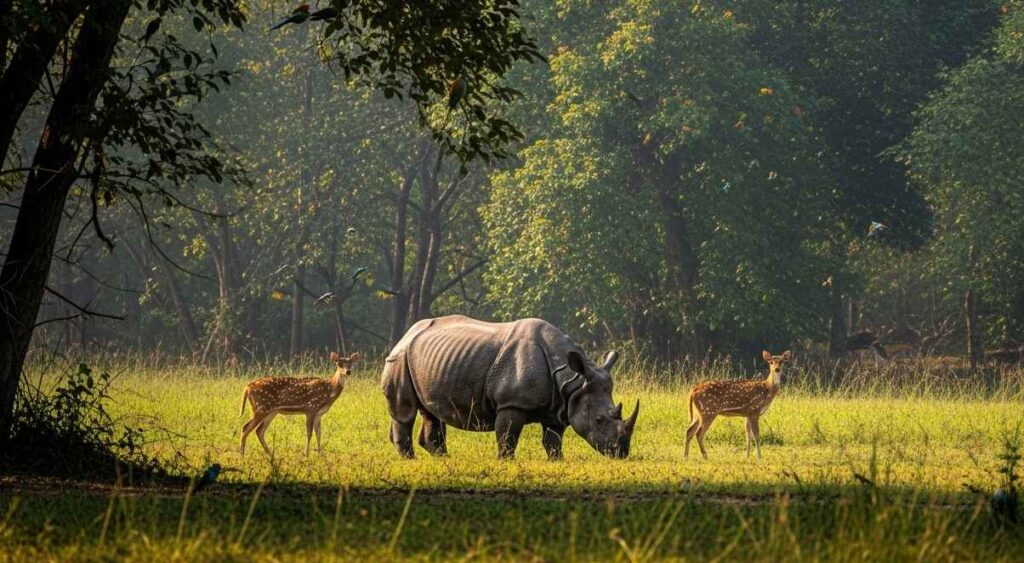
Chitwan National Park: Rich Biodiversity in a Thriving Ecosystem
Located in Nepal’s Terai region, Chitwan National Park is home to a wide range of wildlife in its tropical and subtropical forests, grasslands, and riverine areas. A large portion of the park is covered in Sal (Shorea robusta) forest, offering dense and vibrant habitat for many species.
Chitwan is renowned for its high density of one-horned rhinoceroses, with over 700 individuals. The park also hosts a thriving population of Bengal tigers, Asian elephants, leopards, sloth bears, deer species (including spotted deer and Sambar deer), wild boar, langurs, and rhesus macaques.
The park is especially rich in birdlife, with over 500 species of birds including Great Hornbill, Bengal florican, Sarus Crane, Peafowl, and Grey-headed Fish Eagle. Reptiles such as Mugger crocodiles, Gharial crocodiles, Monitor lizards, and Indian Rock Pythons also inhabit the area.
Visitors can enjoy a variety of activities including jeep safaris, elephant safaris, canoe rides, jungle walks, and cultural tours. Chitwan’s well-established infrastructure offers ample accommodation options and makes it a great choice for both families and wildlife enthusiasts.
Bardia National Park: Peaceful Wilderness with Prime Tiger Sightings
Further west in the Terai, Bardia National Park offers a more remote and tranquil experience, perfect for those seeking a deeper connection with nature. The park features less dense vegetation, open grasslands, and riverine areas, making wildlife easier to observe.
Bardia is known for its higher chance of tiger sightings, with excellent visibility in its vast natural landscape. The park also shelters Asian elephants, one-horned rhinos (around 37 individuals), leopards, nilgai antelopes, hog deer, Blue Bull, Gaur (Indian Bison), and Gangetic dolphins.
This park is a haven for bird watchers, with species such as Lesser Adjutant Stork, White-rumped Vulture, sliver-eared mesia, and Lesser florican. Reptiles include King Cobra, Indian Rock Python, Monitor Lizard, and Gharial crocodile.
Activities in Bardia focus on jeep safaris, jungle walks, bird watching, and cultural encounters with the Tharu people. With fewer visitors, the experience is serene, ideal for those preferring an authentic wilderness experience. It is also a budget-friendly destination with lower costs and natural charm.
Both Chitwan and Bardia offer immersive wildlife adventures. Choose Chitwan for its rhino population, bird diversity, and developed tourism, or explore Bardia for a quiet escape, tiger tracking, and a true natural adventure in Nepal’s untouched beauty.
Safari Experience: Which Jungle Adventure Is Right for You?
Chitwan National Park is ideal for families and first-time travelers, offering comfort, accessibility, and organized tours. Bardia National Park suits those seeking a more immersive and secluded adventure, with higher chances of Bengal tiger sightings and an authentic jungle feel.
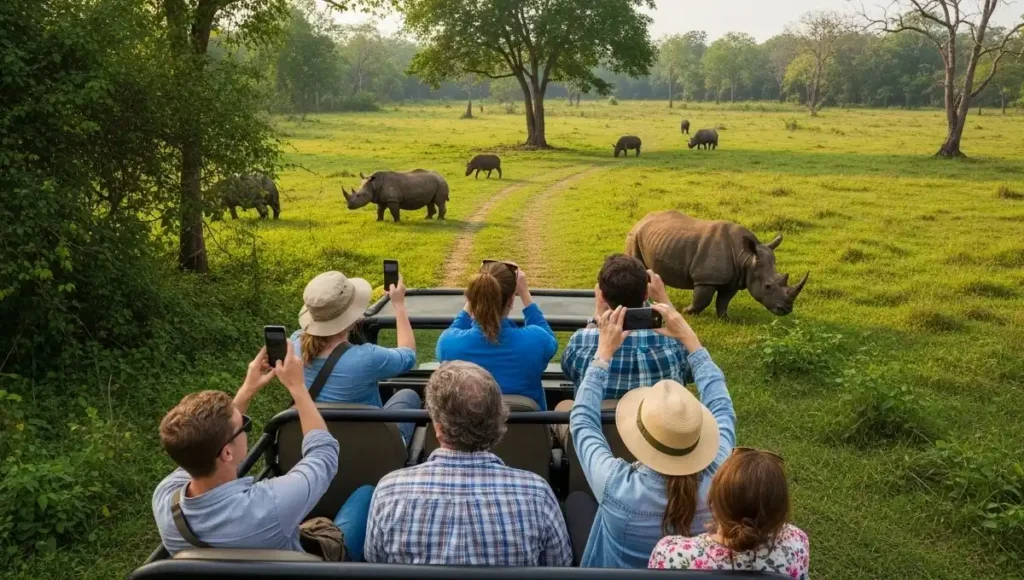
Types of Safaris Offered
Both Chitwan and Bardia National Parks offer a wide range of safari experiences:
- Jeep Safari: Explore deep jungle trails in a 4×4. Great for spotting large mammals like the one-horned rhinoceros, Bengal tigers, and wild elephants.
- Elephant Safari: A traditional way to observe wildlife safely while getting closer to nature.
- Walking Safari: Perfect for adventurers wanting a quiet, immersive jungle experience.
- Canoe Ride: Glide along the Rapti or Karnali River, spotting birds, reptiles, and aquatic animals.
- Birdwatching: Especially rewarding in both parks, with up to 470 bird species and many endemic birds.
- Jungle/Nature Walks: Guided explorations on foot for close interaction with flora and fauna.
- Tharu Cultural Tours: Learn about the lifestyle and heritage of the Tharu people living near both parks.
Tour Duration & Booking Options
You can choose from a variety of flexible itineraries:
- Chitwan: Popular durations are 2-day, 3-day, or 4-day tours. Best suited for shorter stays and families.
- Bardia: Often 3-day to 5-day packages are ideal for deeper exploration.
- Booking Options:
- Local Tour Operators in both parks offer customizable experiences.
- Travel Agencies like Tripadvisor, GetYourGuide, and Mission Himalaya Trek provide ready-made packages.
- Private or Group Bookings are available depending on budget and preference.
Safari Costs: Chitwan vs Bardia (2025 Prices)
Chitwan is more budget-friendly for short stays, while Bardia offers high-value multi-day experiences:
Chitwan National Park
- 2 Nights/3 Days Group Tour: From $160 (solo), $155 per person (2–6 group size)
- Solo Tour: Approx. $325
- Jeep Safari: NPR 2,500 per person (half-day), NPR 4,000 (full-day)
- Canoe Ride: NPR 1,000 (locals), NPR 5,000 (foreigners)
Bardia National Park
- 4 Nights/5 Days Group Tour: Around $999
- 3 Nights/4 Days: Approx. $950 per person
- 2 Nights/3 Days: Around $800 per person
- Full Day Jeep Safari: ~$250 per jeep, shareable among travelers
- Walking Safari: $50/day (includes park entry and lunch)
- Rafting Add-ons: Inquire at your lodge
Private vs Group Safari Pros & Cons
Private Safaris
Pros:
- Full customization and flexibility
- Privacy and tailored pace
- Dedicated guide and personalized experience
- Ideal for couples, families, and photography
Cons:
- Higher costs due to exclusive arrangements
- Less opportunity for social interaction
Group Safaris
Pros:
- Cost-effective
- Great for meeting like-minded travelers
- Simple logistics handled by operators
Cons:
- Fixed itineraries
- Less privacy and personal space
Choose Chitwan if you want a convenient, family-friendly safari with a range of comfortable amenities, great for shorter visits from Kathmandu or Pokhara. It’s also ideal for those who enjoy structured, organized wildlife experiences.
Choose Bardia if you seek a remote, peaceful, and authentic wilderness adventure, especially to increase your chances of Bengal tiger sightings. With a dense tiger population, expansive 928 sq km territory, and pristine jungle, Bardia is perfect for true wildlife explorers and adventure lovers.
Accommodation Options: Lodges, Hotels, and Homestays
Chitwan and Bardia National Parks offer a wide range of accommodation options, including eco-lodges, riverside resorts, budget homestays, and luxury retreats. Whether you prefer peaceful nature stays or full-service hotels, both parks have something ideal for your comfort, style, and budget
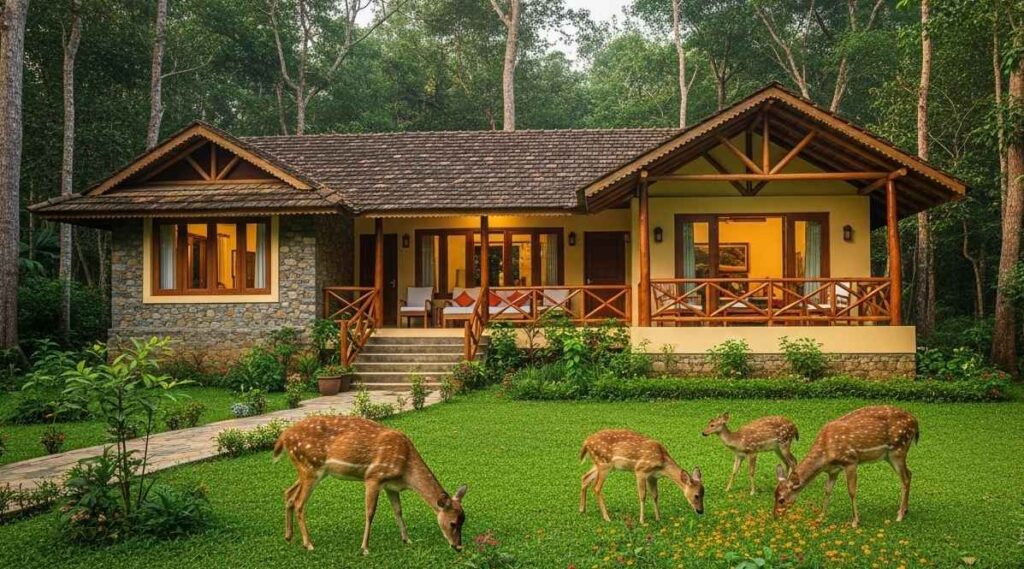
Accommodation in Chitwan National Park
Chitwan is known for its variety of lodges, hotels, and homestays, mainly around Sauraha, the park’s main tourist hub. Visitors can choose from budget hotels to high-end resorts, depending on their preferences and comfort level.
Popular picks include:
- Rhino Lodge, Jungle Villa Resort, and Hotel Jungle Annexe – known for their proximity to the park and great amenities.
- Sapana Village Lodge – a high-end hotel offering beautiful surroundings and a peaceful experience.
- Hotel National Park Sauraha and Chitwan Village Resort – great mid-range options with warm hospitality.
- For something unique, Tiger Tops offers Tharu Lodge and Elephant Camp, with tented accommodations and elephant care experiences.
- Welcome Nepal Treks also features the Private Tower Night Stay, perfect for those wanting something different.
If you enjoy trying different foods, Sauraha has several restaurants like Shantiko Kitchen, Friends Cafe, Greasy Spoon Restaurant, and KC’s Restaurant and Bar, offering cozy spots near the river and sunset viewpoint.
Accommodation in Bardia National Park
Bardia offers a more off-the-beaten-path feel, with homestays, eco lodges, and luxury resorts scattered around Thakurdwara.
Top options include:
- Bardia Homestay, Bardia Eco Friendly Homestay, and Nanu’s Bardiya Homestay – perfect for travelers looking for budget-friendly stays and local hosts.
- Mr. B’s Place – a family-run establishment praised for its cleanliness, comfort, and fresh food.
- Bardia Forest Resort and Bardia Eco Lodge – offer eco-conscious practices and a peaceful setting near nature.
- Tiger Tops Karnali Resort – for a luxurious resort experience with full amenities and services.
- Wild Planet Eco Retreat and Forest Hideaway Resort – top-rated properties for travelers who want a balance of comfort and nature.
- Bardia Riverside View Park Resort – offers a mix of American, Indian, and Nepalese cuisine, served with a view.
Each option blends beautifully with the natural environment, offering a unique experience for every traveler.
Food & Local Dining: What to Expect
The local food in Chitwan and Bardia National Park is full of flavor and culture. Many lodges, resorts, and eco-lodges offer farm-to-table dining using locally grown produce. Meals are often made with fresh, locally sourced ingredients, giving every dish a special homemade touch.
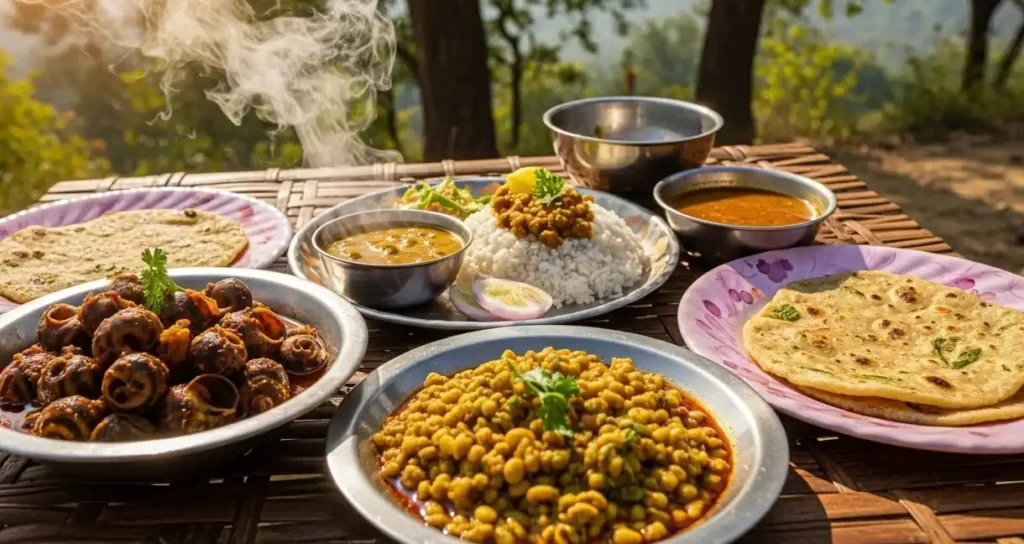
You’ll find authentic dishes like dal bhat (lentils and rice), vegetable curries, and noodle dishes, all staples of Nepali cuisine. The Tharu people also bring their unique culinary traditions with dishes like ghonghi (snail curry) and dhikri (rice flour dumplings), served as regional specialties.
Dining is more than just eating—it’s an experience. Some places even offer cooking classes where local hosts guide you through traditional cooking, from ingredient sourcing to preparation techniques.
Whether you dine at restaurants in nearby villages like Thakurdwara, or enjoy meals within accommodations, the food is always satisfying. Pair your meals with local beverages such as Nepali tea for the full experience.
Safety, Health & Travel Tips (2025 Edition)
For a safe, healthy, and exciting visit in 2025, both Chitwan and Bardia National Parks in Nepal offer unique wildlife experiences with guided safaris, rich biodiversity, and proper infrastructure.
Chitwan is more accessible and popular, while Bardia offers a more natural and peaceful setting with excellent wildlife sightings.
With the right preparation—like packing appropriate gear, choosing reputable guides, and following safety tips—you can enjoy a secure and memorable trip to either park.
Chitwan National Park
Chitwan is an ideal choice for travelers looking for convenience and variety. It’s easily accessible from Kathmandu, making it a great option for those with limited time.
The infrastructure is developed, and the park sees a good volume of tourists who come for diverse activities like jeep safaris, canoe trips, walking tours, and even elephant riding.
Wildlife enthusiasts enjoy spotting one-horned rhinoceros, Bengal tigers, and vibrant birdlife. Guides are trained and reputable, offering essential instructions for a safe and smooth tour.
To prepare well, pack appropriate clothing, sunscreen, and insect repellent. Following designated paths and staying aware of your surroundings ensures a secure experience.
Bardia National Park
Bardia is perfect for those seeking a more natural, peaceful adventure. While it takes a bit more travel time to reach, the reward is a tranquil environment rich in wildlife and cultural charm.
Visitors often enjoy cultural exchanges with the Tharu community and unique walking safaris through open forests and grassy plains.
Sightings of Bengal tigers, leopards, elephants, and even Gharial crocodiles are more frequent here, offering a truly memorable trip. As always, listen to your guide, follow all protocols, and maintain a respectful distance from animals.
Bring gear for varying weather, especially during monsoon season, and take time to acclimatize properly. Choosing reputable operators, staying informed, and taking smart precautions will make your Bardia visit just as rewarding.
With the right mindset, both Chitwan and Bardia offer safe, exciting, and fulfilling journeys into Nepal’s wild beauty.
Which Park Is Best for You? Tailored Recommendations
Chitwan National Park is ideal for visitors seeking a wide range of activities, ease of access, and established tourism infrastructure.
Bardia National Park offers a more serene, remote jungle experience and higher chances of spotting tigers, making it perfect for wildlife enthusiasts and adventure travelers. The best park depends on your travel style and what kind of experience you want.
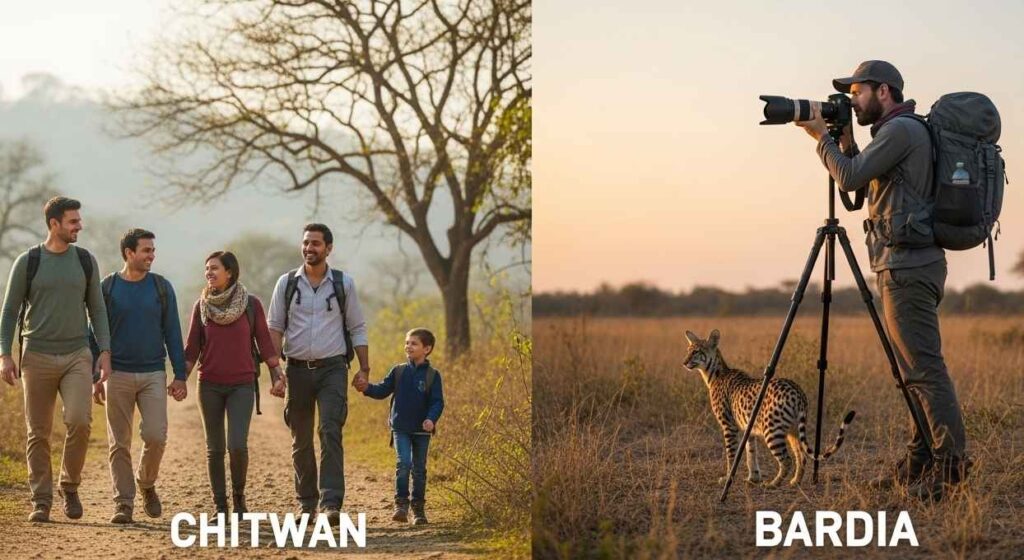
Best for Wildlife Enthusiasts
If you’re passionate about wildlife and love being surrounded by nature, Bardia National Park is a top choice. It’s known for its authentic jungle experience, peaceful environment, and higher chances of tiger sightings.
The wilderness here feels untouched, and the opportunities for jungle walks let you connect deeply with the natural world.
Many enthusiasts visit Bardia to see Bengal tigers, rhinos, elephants, and various bird species in their natural habitat. The park is also a great place for canoeing along the Karnali River, offering a unique view of its rich ecosystem.
Best for First-Time Visitors to Nepal
For those visiting Nepal for the first time, Chitwan National Park is often the most accessible and suitable choice. It’s located close to Kathmandu, with easy transportation options like a short flight or drive.
The park has a well-developed tourism infrastructure, making it simple to plan safaris, canoe rides, and cultural activities.
The nearby town of Sauraha offers many restaurants, hotels, and tour agencies, allowing for a comfortable and convenient stay.
Rhino sightings are more frequent here, and you’ll find a wider range of activities to choose from, ideal for families and groups.
Best for Offbeat, Solo, or Adventure Travelers
If you’re a solo traveler or someone seeking a more off-the-beaten-path adventure, Bardia is a fantastic pick. The remote location, fewer crowds, and serene environment make the experience feel more immersive and unique.
The authentic culture in Thakurdwara, where most safaris start, adds to the charm. You’ll enjoy exploring the jungle on foot, spotting wildlife, and staying at local lodges that reflect the traditional Tharu culture.
Whether it’s walking safaris or peaceful canoeing, Bardia offers an unforgettable and meaningful experience for the adventure-minded.
Both Chitwan and Bardia National Parks are excellent in their own ways. Your choice depends on your preferences, travel priorities, and the kind of experience you want.
Pros and Cons of Chitwan vs Bardia
Chitwan and Bardia are two of Nepal’s top national parks, each offering unique wildlife experiences. Chitwan is ideal for easy access and rich infrastructure, while Bardia provides a peaceful, untouched wilderness perfect for immersive safaris and tiger sightings
Both Chitwan and Bardia National Parks are incredible places to enjoy wildlife in Nepal. They cater to different preferences but are equally rich in natural beauty, sightings, and unforgettable experiences. Here’s a clear comparison to help you choose the one that fits your adventure style best.
Pros of Chitwan National Park
- Accessible from major cities like Kathmandu; very convenient
- Well-developed infrastructure with plenty of accommodation, restaurants, and tour operators
- High chances of spotting rhinos and other majestic creatures
- Offers a variety of safaris: jeep, elephant, and walking
- Popular destination with diverse facilities
- Strong focus on safety and visitor comfort
- Ideal for those looking for a comfortable, westernized experience
Pros of Bardia National Park
- Secluded and pristine, great for a true wilderness experience
- Known for tiger sightings and rare elusive cats
- Great for jungle walks and ecologically friendly exploration
- Peaceful, intimate setting with fewer visitors
- Rich in natural beauty with minimal human impact
- Offers an authentic, immersive safari adventure
Neutral Considerations
- Chitwan offers more comfort and amenities, perfect for travelers who value ease.
- Bardia takes more time and effort to reach, but rewards visitors with a remote and untouched environment.
- Both parks are among Nepal’s top choices and suit different individual priorities.
No matter which park you choose, both offer a great option to explore, witness wildlife, and create unforgettable memories in Nepal’s incredible National Parks.
Suggested Itineraries & Combined Trips
Planning a combined trip to Chitwan and Bardia gives you two unique adventures in one journey. Start your itinerary with Chitwan, where you can stay in Sauraha near the national park.
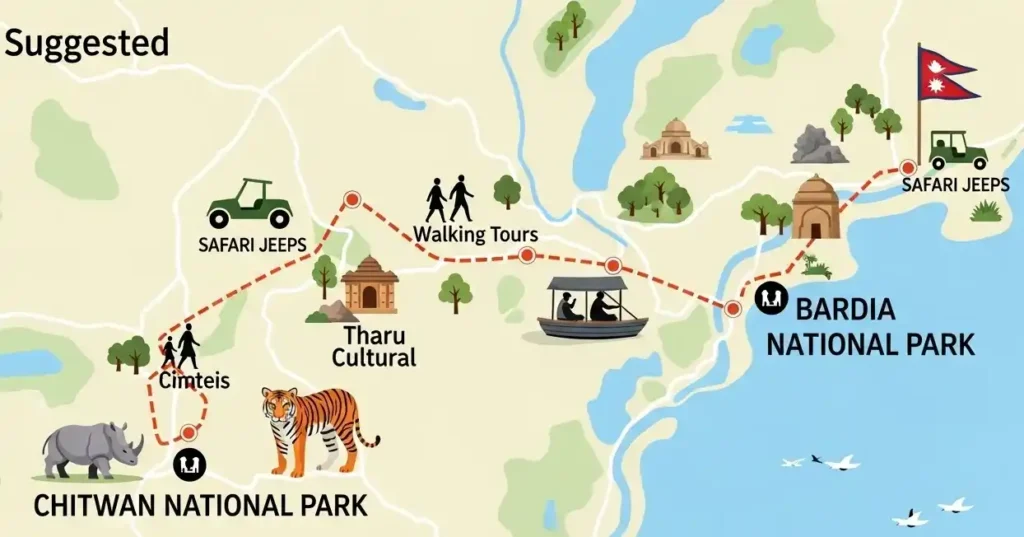
Enjoy a Tharu cultural program in the evening, go on jeep safaris, try canoeing on the Rapti River, and explore the flora and fauna on a jungle walk. Don’t miss the elephant breeding center, bird watching, and an optional visit to the Tharu museum.
After 3–4 days, fly from Bharatpur to Nepalgunj and drive to Bardia. This park is known for its authentic wilderness and peaceful setting. Activities include full-day jeep safaris, picnic lunch in the wild, and nature walks near the buffer zone.
The chances to spot tigers, rhinos, and rare birds make it an enriching experience. For the best wildlife experience, visit in winter (especially November or February) and consider hiring a guide with deep expertise.
Both parks offer a range of accommodation, from basic lodges to luxurious resorts, and plenty of exciting activities. Whether you’re into bird tours, cultural tours, or peaceful jungle walks, this combination gives you the perfect taste of Nepal’s wild side.
Conclusion
Bardia and Chitwan are two of Nepal’s top places for wildlife and jungle safaris. Each offers a unique and rich jungle experience, filled with beauty, wildlife, and nature. Chitwan is perfect for those looking for convenience and easy access, with a lively town like Sauraha nearby where you can relax, chill, and enjoy local restaurants. It is well-suited for a shorter trip or family-friendly tourism.
In contrast, Bardia is more authentic and remote. It gives a peaceful and deeper adventure into the wild. Known for its tigers, Bardia offers a true safari feel—what many call Chitwan twenty years ago. It’s a great destination for travelers who enjoy tranquility, passion, and exploring off the beaten path.
Both places allow for spotting rare animals like tigers and rhinos, though sightings depend on luck and patience. Choosing between them really depends on your type of adventure. If you want to simplify your planning, think about what kind of traveler you are and what experience matters most to you. Either way, it will be a journey to remember full of lasting memories.
Whether you’re after a calm escape or thrilling exploration, both Bardia and Chitwan promise a beautiful lifetime experience in the heart of Nepal.
FAQs: Chitwan or Bardia (2025)
Which is better, Chitwan or Bardiya?
Both Chitwan and Bardiya are great for wildlife. Chitwan is easier to reach and has more hotels and activities. Bardiya is quieter, more natural, and offers better chances to see tigers. Choose Chitwan for comfort and variety; pick Bardiya for peace and adventure.
What are the top 3 national parks in Nepal?
Nepal’s top three national parks are Chitwan National Park, Bardiya National Park, and Sagarmatha National Park. Chitwan is best for rhinos, Bardiya for tigers, and Sagarmatha for mountain views and trekking near Everest.
Is Bardia National Park worth visiting?
Yes, Bardiya is worth visiting. It has fewer tourists, peaceful jungle walks, and great chances to see tigers, elephants, and birds. The natural beauty and quiet make it special for nature lovers and wildlife fans.
What is Bardiya National Park mostly famous for?
Bardiya is mostly famous for Bengal tiger sightings. The open grasslands and peaceful rivers make it easier to see wildlife. It’s also known for jungle hikes and the culture of the Tharu people.
How many tigers are in Bardiya National Park?
Bardiya National Park has one of the highest chances to see tigers in Nepal. While the exact number can change, it is known to have a growing and healthy tiger population thanks to its large protected habitat.
Is Chitwan worth it in 2025?
Yes, Chitwan is definitely worth visiting in 2025. It’s easy to get to, full of activities, and great for spotting rhinos, birds, and even tigers. The weather in spring and fall makes it perfect for safaris.
Can I see tigers in Chitwan or Bardia?
Yes, you can see tigers in both parks. Chitwan has some tiger sightings, but Bardia offers a better chance. The open forest and quiet trails in Bardia make it easier to spot them.
How long should I stay in Bardia?
You should stay 3 to 5 days in Bardia. This gives enough time for jungle walks, jeep safaris, and relaxing in nature. More days mean more chances to see tigers and enjoy the peaceful setting.
Is Bardia too remote for first-timers?
Bardia is remote, but it’s still great for first-timers who love nature and don’t mind a longer trip. It’s safe, friendly, and offers a true jungle adventure. Guides and lodges make the stay easy and fun.
Can I do both parks in one trip?
Yes, you can visit both parks in one trip. Start with Chitwan, then fly or drive to Bardia. It’s a great way to enjoy two different jungle experiences — Chitwan for variety, Bardia for quiet and tigers.
Disclaimer
This article is for informational purposes only. Safari experiences, sightings, and conditions may vary. Always confirm latest travel info with official sources or guides. For more, visit TravelDrizzle.com.
